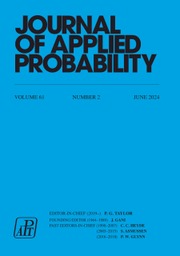No CrossRef data available.
Article contents
Limit theorems of stochastic differential equations with jumps
Part of:
Stochastic analysis
Published online by Cambridge University Press: 16 June 2025
Abstract
This work concerns stochastic differential equations with jumps. We prove convergence for solutions to a sequence of (possibly degenerate) stochastic differential equations with jumps when the coefficients converge in some appropriate sense. Then some special cases are analyzed and some concrete and verifiable conditions are given.
MSC classification
Information
- Type
- Original Article
- Information
- Copyright
- © The Author(s), 2025. Published by Cambridge University Press on behalf of Applied Probability Trust
References
Anulova, S. and Pragarauskas, H. (1977). Weak Markov solutions of stochastic equations. Lithuanian Math. J. 17, 5–26.CrossRefGoogle Scholar
Bally, V., Goreac, D. and Rabiet, V. (2018). Regularity and stability for the semigroup of jump diffusions with state-dependent intensity. Ann. Appl. Prob. 28, 3028–3074.CrossRefGoogle Scholar
Figalli, A. (2008). Existence and uniqueness of martingale solutions for SDEs with rough or degenerate coefficients. J. Funct. Anal. 254, 109–153.CrossRefGoogle Scholar
Fournier, N. and Xu, L. (2019). On the equivalence between some jumping SDEs with rough coefficients and some non-local PDEs. Ann. Inst. H. Poincaré Prob. Statist. 55, 1163–1178.CrossRefGoogle Scholar
Huang, L. (1987). Weak convergence of a class of jump processes. Chinese J. Appl. Prob. Statist. 3, 243–249.Google Scholar
Jacod, J. (1979). Calcul stochastique et problémes de martingales (Lect. Notes Math, 714). Springer, Berlin.Google Scholar
Jacod, J. and Shiryaev, A. N. (1987). Limit Theorems for Stochastic Processes. Springer, Berlin.CrossRefGoogle Scholar
Karatzas, I. and Shreve, S. E. (2005). Brownian Motion and Stochastic Calculus, 2nd edn. (Grad. Texts Math. 113). Springer, New York, pp. 284–295.Google Scholar
Kasahara, Y. and Yamada, K. (1991). Stability theorem for stochastic equations with jumps. Stoch. Process. Appl. 38, 13–32.CrossRefGoogle Scholar
Kawabata, S. and Yamada, T. (1982). On some limit theorems for solutions of stochastic differential equations. In Séminaire de Probabilités XVI (Lect. Notes Math. 921), eds J. Azéma and M. Yor. Springer, Berlin, pp. 412–441.CrossRefGoogle Scholar
Kurtz, T. G. (1970). Solutions of ordinary differential equations as limits of pure jump Markov processes. J. Appl. Prob. 7 49–58.CrossRefGoogle Scholar
Kurtz, T. G. (1971). Limit theorems for sequences of jump Markov processes approximating ordinary differential processes. J. Appl. Prob. 8, 344–356.CrossRefGoogle Scholar
Qiao, H. (2014). Exponential ergodicity for SDEs with jumps and non-Lipschitz coefficients. J. Theoret. Prob. 27, 137–152.CrossRefGoogle Scholar
Qiao, H. (2014). Euler–Maruyama approximation for SDEs with jumps and non-Lipschitz coefficients. Osaka J. Math. 51, 47–66.Google Scholar
Qiao, H. (2022). Limit theorems of SDEs driven by Lévy processes and application to nonlinear filtering problems. Nonlinear Diff. Equ. Appl. 29, 8.CrossRefGoogle Scholar
Qiao, H. and Zhang, X. (2008). Homeomorphism flows for non-Lipschitz stochastic differential equations with jumps. Stoch. Process. Appl. 118, 2254–2268.CrossRefGoogle Scholar
Rozkosz, A. and Slomiński, L. (1991). On existence and stability of weak solutions of multidimensional stochastic differential equations with measurable coefficients. Stoch. Process. Appl. 37, 187–197.CrossRefGoogle Scholar
Rozkosz, A. and Slomiński, L. (1997). On stability and existence of solutions of SDEs with reflection at the boundary. Stoch. Process. Appl. 68, 285–302.CrossRefGoogle Scholar
Röckner, M., Xie, L. and Zhang, X. (2020). Superposition principle for non-local Fokker–Planck operators. Prob. Theory Relat. Fields 178, 699–733.CrossRefGoogle Scholar
Stroock, D. W. (1975). Diffusion processes associated with Lévy generators. Z. Wahrscheinlichkeitsth. 32, 209–244.CrossRefGoogle Scholar
Stroock, D. W. and Varadhan, S. R. S. (1979). Multidimensional Diffusion Processes (Grundlehren Math. Wiss. 233). Springer, Berlin.Google Scholar
Yamada, K. (1984). A stability theorem for stochastic differential equations and application to stochastic control problems. Stochastics 13, 257–279.CrossRefGoogle Scholar
Yamada, K. (1986). A stability theorem for stochastic differential equations with application to storage processes, random walks and optimal stochastic control problems. Stoch. Process. Appl. 23, 199–220.CrossRefGoogle Scholar
Zhang, X. (2013). Degenerate irregular SDEs with jumps and application to integro-differential equations of Fokker–Planck type. Electron. J. Prob. 18, 1–25.CrossRefGoogle Scholar


